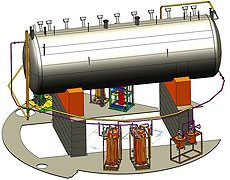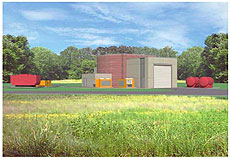DOE grants MicroBooNE third-stage approval

The MicroBooNE experiment will feature a 33-foot-long neutrino detector, the largest of its kind in America.

Fermilab plans to break ground in November for this liquid-argon R&D building, future home of the MicroBooNE experiment. The building will be located across the road from the MiniBooNE experiment.
The MicroBooNE neutrino experiment at Fermilab has received Critical Decision 2-3a approval from the Department of Energy, the third stage of the four-stage DOE approval process prior to construction. CD 2-3a authorizes the MicroBooNE collaboration to make purchases of construction items that require a long lead time, such as cryogenic systems. Full approval to start construction is planned for 2012.
"It feels great to be at this point," Yale physicist and MicroBooNE spokesperson Bonnie Fleming said about the approval, which followed a thorough DOE review of the MicroBooNE project plans about a month ago. "We were well prepared for the review, and we were commended for the work we had done. We were given very few recommendations."
The MicroBooNE experiment is one of several construction jobs to take place at Fermilab in the next couple of years. They include:
- The Illinois Accelerator Research Center, with the groundbreaking scheduled for this fall;
- The construction of the near detector for the NOvA neutrino experiment, which will start in 2012 in the MINOS underground hall;
- Upgrades to the Fermilab accelerator complex, which include replacing one of the Cockcroft-Walton pre-accelerators with a more efficient proton source and reconfiguring the Main Injector and the Recycler Ring to create amore intense proton beam for neutrino production;
- The assembly of a 460-feet-long SRF test accelerator in the New Muon Lab building.
About 60 scientists and engineers have been working on the plans for the MicroBooNE experiment, which will use a 170-ton neutrino detector based on liquid-argon technology. It will be the largest one ever built in the United States. The collaboration aims to advance the use of liquid argon in neutrino research while solving a long-standing riddle about low-energy neutrino interactions that could indicate the presence of a new type of neutrino known as a sterile neutrino.
"It's an incredibly exciting time in neutrino physics," Fleming said. "The latest announcement about neutrinos perhaps traveling faster than the speed of light adds to the excitement."
Assembly of the 33-foot-long MicroBooNE detector is scheduled to begin in early 2012 and will take place in the DZero high-bay area.
This November, Fermilab will break ground for a liquid-argon R&D building, to be located across the road from MiniBooNE. The building will house a brand new, liquid-argon-based cryogenics system. The MicroBooNE collaboration plans to move its assembled detector to the new building in 2013 and be the first experiment to use the system.
"Part of our goal is to find out how quickly we can achieve a high level of purity in the liquid-argon-filled particle detector and gain more experience in identifying neutrino events in liquid argon," said Gina Rameika, MicroBooNE project manager at Fermilab. "MicroBoone will see neutrinos both from the Booster and NuMI beam lines and add breadth to Fermilab's neutrino program."
The National Science Foundation has contributed $2 million toward the purchase of detector components. The DOE Office of Science will provide $19.9 million for the construction of the project.
—Kurt Riesselmann
|